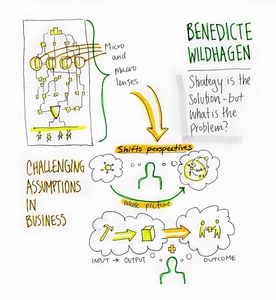Strategy is the solution – but what is the problem?
Wildhagen, Benedicte (2014) Strategy is the solution – but what is the problem? In: Proceedings of RSD3, Third Symposium of Relating Systems Thinking to Design, 15-17 Oct 2014, Oslo, Norway.
Preview |
Text
Wildhagen_Stategy_2014.pdf Download (1MB) | Preview |
![Wildhagen_MindMap_2014.jpg [thumbnail of Wildhagen_MindMap_2014.jpg]](https://openresearch.ocadu.ca/2106/2.hassmallThumbnailVersion/Wildhagen_MindMap_2014.jpg)  Preview |
Image
Wildhagen_MindMap_2014.jpg Download (415kB) | Preview |
Preview |
Text
Wildhagen_Slides_2014.pdf Download (1MB) | Preview |
Abstract
I will address the relevance of Systems Oriented Design (SOD) in the development of good strategy – and how it can contribute to make sense of a bad strategy. I will showcase how SOD shifts the conversation towards exploration of complexity, diagnosis and the design of actions for strategic impact. My views are based on the accumulated work experience within the Norwegian Centre for Design & Architecture (previously Norwegian Design Council & Norsk Form) and my observations as a sensor for the SOD Master-courses at AHO, which I’ve been following since 2010.
Sevaldson (2013) describes SOD as un-dogmatic and design oriented in its approach to systems. The SOD designer is initially less concerned about hierarchies and boundaries of systems and more interested in looking at vast fields of relations and patterns of interactions. The SOD designer is looking beyond the object (product or service) and perceives the object merely as a “symptom” or “outcropping” of vast systems that lay behind the object. When dealing with very complex issues, SOD regards designing the design process for each individual project, as the central strategy. When we begin scoping complex design processes we promote problem-orientation. The absence of a good strategy quite often becomes apparent and an initial challenge. We need to address this and support the decision makers to diagnose what the problem is, not focus on what the solution might be.
A SOD core team can be brought into the organization, and through team work with key stakeholders be able to explore complexity. The team make a (1) diagnosis that defines or explains the nature of one or more existing, or unprecedented, challenges, they make (2) recommendations on how to deal with the challenges and (3) actions designed to carry them out. Visualization and Giga-mapping are essential tools to enable shared understanding and drive the process forward – from diagnosing to suggested actions.
| Item Type: | Conference/Workshop Item (Paper) |
|---|---|
| Divisions: | Faculty of Design |
| Date Deposited: | 22 Nov 2017 16:19 |
| Last Modified: | 20 Dec 2021 18:31 |
| URI: | https://openresearch.ocadu.ca/id/eprint/2106 |
Actions (login required)
 |
Edit View |

 Tools
Tools Tools
Tools